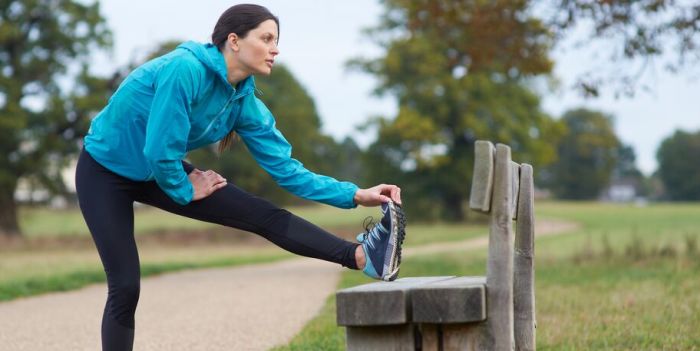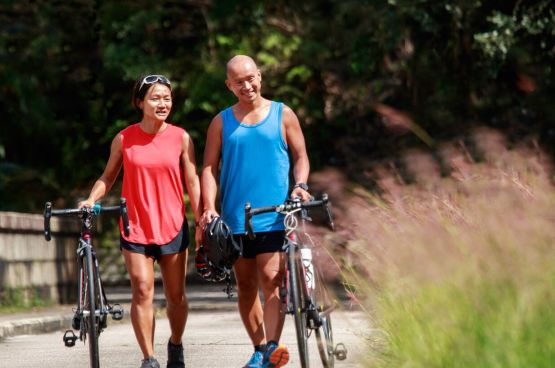How can I avoid muscle cramps when exercising?
You’ve probably had a muscle cramp at one time or another – this is a strong, involuntary contraction in your muscle, which can be painful. When muscle cramps happen during exercise, or immediately afterwards, they’re known as ‘exercise-induced’ or ‘exercise-associated’ muscle cramps. But what causes these cramps? And what can you do to stop them? Read on to find out more.

What is exercise-induced cramp?
Exercise-induced cramps happen in muscles that are normally under your control, called skeletal muscles. But during a cramp, your muscle contracts strongly without you wanting it to, and it can be hard and tender.
Cramps are usually quite short-lived and they can stop as suddenly as they start. But sometimes, the pain and tenderness can last for several hours after the cramp has stopped.
Although any muscle can go into spasm, muscle cramps after exercise mostly affect:
- your calf muscle (gastrocnemius)
- the muscles in your foot
- the group of muscles in the front of your thigh (quadriceps)
- the group of muscles in the back of your thigh (hamstrings)
What causes exercise-induced cramp?
We don’t always know what causes muscle cramps during exercise, but there are two possible causes.
The most recent theory is that exercise-associated muscle cramps are due to muscle tiredness (fatigue).
Another, older idea is that cramp is due to dehydration and low levels of minerals called electrolytes in your body. But the evidence to support this idea isn’t conclusive.
It may be that exercise-induced cramp has different causes in different situations, or that several things work together to cause cramps.
You’re more likely to get exercise-induced muscle cramp if you:
- do endurance sports, such as marathon running
- take part in team sports, such as rugby
- work physically hard or exercise in hot, humid conditions
How do I stop exercise-induced muscle cramp?
You should stop working out if you have a muscle cramp, and gently and slowly stretch the affected muscle. Hold it in a stretched position for up to 30 seconds – aim to feel the muscle relax. You may find it helpful to do this stretch a couple of times.
Try to rest and give your muscle time to recover, or the cramp might return. You might need to reduce the intensity and how long you exercise for until you can exercise without cramp.
If you feel pain for more than eight hours after the cramps stop, see a physiotherapist to rule out an injury. If you have continuous cramps, a GP can help determine if you have an underlying issue.
How can I avoid exercise-induced cramp?
Because no one knows exactly what causes exercise-induced muscle cramp, it’s not certain what the best way to prevent cramp might be. But here are some things that may help.
Warm up and stretch
Although there’s no proof it will work, warming up and regularly stretching your muscles may reduce your chance of cramps.
It’s also helpful to keep your level of general fitness up and to set realistic goals. Slowly building up your fitness and strength allows muscles to adapt, without feeling too overloaded.
Try to get enough rest and build in some recovery sessions if you’re following a training plan. This can help to avoid fatigue, which is a possible cause of cramps.
Keep hydrated
It’s always important to stay properly hydrated when you exercise. You should drink enough water before, during, and after exercise – especially if the weather is hot or humid.
You can tell if you’re dehydrated by the colour of your pee (urine).
If you sweat a lot during exercise, you lose fluid and electrolytes, such as salt (sodium). Although we don’t know for certain, large losses of fluid and electrolytes, through heavy sweating, could cause cramp.
If you’re doing moderate or hard exercise, homemade or commercially-available sports drinks can help replace the fluid and electrolytes you lose through sweat.
If you’re doing low or moderate amounts of physical activity, water should be enough to keep you hydrated.
Balanced diet
It’s important to eat a balanced diet with enough carbohydrates, because this can help prevent muscle tiredness (fatigue) which may cause cramp. Good nutrition also gives you energy to be physically active and can help you recover from exercise.
You may find our tips on eating well for physical activity helpful: download the guide on nutrition for sport and exercise (PDF, 1.2MB). If you’re an athlete in training, you may also find it helpful to get advice from a dietitian with experience of managing sports nutrition.
If you have a muscle, bone or joint problem, our direct access service aims to provide you with the advice, support and treatment you need as quickly as possible. If you’re covered by your health insurance, you’ll be able to get advice from a physiotherapist usually without the need for a GP referral. Learn more today.
-
Sources Sources
- Muscle cramps. Patient. patient.info/doctor, last updated 15 February 2022
- Muscle cramps. Statpearls. Bordoni B Sugumar K and Varacallo M. ncbi.nlm.nih.gov, last updated 4 September 2022
- Muscle cramps. BMJ Best Practice. bestpractice.bmj.com, last updated 13 April 2023
- Miller Kc McDermott Bp Yeargin Sw Et Al. An evidence-based review of the pathophysiology, treatment, and prevention of exercise-associated muscle cramps. J Athl Train 2022; 57(1):5-15. doi: 10.4085/1062-6050-0696.20
- Sport and exercise: Food fact sheet. British Dietetic Association. bda.uk.com, reviewed May 2023
- Muscle cramps. MSD Manual Professional Version. msdmanuals.com, modified September 2022
- The importance of hydration. British Dietetic Association. bda.uk.com, published 19 August 2019
- Nutrition for sports and exercise. British Nutrition Foundation. nutrition.org.uk, reviewed April 2020
- Belval LN, Hosokawa Y, Casa DJ, et al. Practical hydration solutions for sports. Nutrients 2019;11:1550. DOI:10.3390/nu11071550
- Moustafa IM, Ahbouch A, Palakkottuparambil F, et al. Optimal duration of stretching of the hamstring muscle group in older adults: a randomized controlled trial. Eur J Phys Rehabil Med 2021;57:931-939. DOI: 10.23736/S1973-9087.21.06731-9
- Page P. Current concepts in muscle stretching for exercise and rehabilitation. Int J Sports Phys Ther 2021;7:109-119
About our health information
At Bupa we produce a wealth of free health information for you and your family. This is because we believe that trustworthy information is essential in helping you make better decisions about your health and wellbeing.
Our information has been awarded the PIF TICK for trustworthy health information. It also follows the principles of the The Information Standard.

More exercise and fitness articles
Did you find our advice helpful?
We’d love to hear what you think. Our short survey takes just a few minutes to complete and helps us to keep improving our healthy lifestyle articles.
Legal disclaimer
This information was published by Bupa's Health Content Team and is based on reputable sources of medical evidence. It has been reviewed by appropriate medical or clinical professionals and deemed accurate on the date of review. Photos are only for illustrative purposes and do not reflect every presentation of a condition.
Any information about a treatment or procedure is generic, and does not necessarily describe that treatment or procedure as delivered by Bupa or its associated providers.
The information contained on this page and in any third party websites referred to on this page is not intended nor implied to be a substitute for professional medical advice nor is it intended to be for medical diagnosis or treatment. Third party websites are not owned or controlled by Bupa and any individual may be able to access and post messages on them. Bupa is not responsible for the content or availability of these third party websites. We do not accept advertising on this page.







